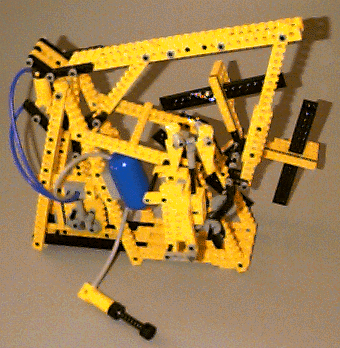A LEGO Technic ``Steam'' Engine

Quick-Time
movie of the engine at work
Complete
building instructions by Dr. C. S. Soh
This double-action compressed-air engine, which is built with standard LEGO
Technic components, illustrates some simple
principles of thermodynamics and mechanics. And it was a lot of fun to build!
Compressed air from the blue tank goes via the the
gray hose through the valve and one of the two blue hoses to the cylinder.  As the piston reaches the end of its
stroke, the vertical pendulum hits the valve and shifts the high-pressure air
to the other side of the piston, driving it in the
As the piston reaches the end of its
stroke, the vertical pendulum hits the valve and shifts the high-pressure air
to the other side of the piston, driving it in the  opposite direction while the side which
was previously connected to the tank is opened to the outside for exhaust. This
``double-action'' was first introduced in steam engines in the late 18th
century. The pendulum-activated valve performs the same function as the slider
valve in a real steam engine. The rotating thing which looks like a centrifugal
governor is really just a decoration, so
opposite direction while the side which
was previously connected to the tank is opened to the outside for exhaust. This
``double-action'' was first introduced in steam engines in the late 18th
century. The pendulum-activated valve performs the same function as the slider
valve in a real steam engine. The rotating thing which looks like a centrifugal
governor is really just a decoration, so  that the engine has something to drive and
I could build a simple gearbox.
that the engine has something to drive and
I could build a simple gearbox.
The back-and-forth (reciprocating) motion of the piston is converted to
rotation with the ``walking-beam,'' rod, and crank mechanism. The angular
momentum stored in the large flywheel helps the engine past its ``dead
points.'' The whole machine looks much like an early 19th-century steam engine.
A physicist will notice one important difference between this machine and a
real steam engine: this engine is not a heat engine. Instead of working
between a hot and a cold reservoir (the boiler and the condenser), it extracts
mechanical work by moving air from a high-pressure resservoir,
the tank (which is far too small to be an ideal reservoir), to a low-pressure
reservoir, the atmosphere.
The three figures of historic steam engines and engine parts which
illustrate this page are from D.H. Thurston, A
History of the Growth of the Steam-Engine (Appleton, New York, 1878).
They show Boulton and Watt's double-action steam
engine from 1784 (left), Stephenson's slider-valve mechanism from 1833 (top
right), and Watt's centrifugal governor (bottom right). Thurston's book is made
available on the Web by the Steam
Engine Library project of the University
of Rochester Department of History.
This is the
only single-cylinder LEGO compressed-air engine I am aware of. Several
beautiful designs with two or more cylinders can be found at these sites:
Dr. C. S. Soh: http://www.fifth-r.com/cssoh1/contents.htm
and
Joe Nagata: http://homepage3.nifty.com/mindstorms/
The multicylinder designs do away with the need for
the large flywheel and walking beam, so these designs can be quite compact,
compared to this one. My own recent experiments with two-cylinder ``steam
cars'' can be found here.